If your senior dog has been diagnosed with laryngeal paralysis you may wonder if tie back surgery is the right treatment option. You may know the risks and benefits, yet you may feel overwhelmed by the decision. Integrative veterinarian Dr. Julie Buzby became a proponent of tie back surgery, not by what she’d learned in veterinary school, but by learning from her patients. On the blog this week, she shares the stories of two dogs with laryngeal paralysis whose owners chose tie back surgery and had no regrets. While there is no one-size-fits-all solution to a disease like lar par, our hope is that these stories are helpful as you wrestle with your decision.
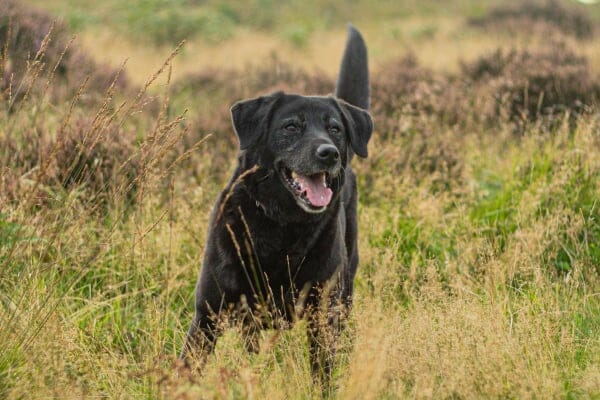
Struggling to breathe: Max’s story
“Trouble breathing” is not something I ever like to see on my list of appointments. Breathing issues can be true emergencies and many times end with me sharing bad news to owners.
I didn’t have to ask why Max was there to see me that day. His respiratory effort and heart rate were extremely labored—so much so, I could hear him struggling to breathe down the hallway. Although his tail was still wagging, you could tell that he was tired, anxious, and fighting.
Max was a 12-year-old, rather chunky, yellow Labrador Retriever. He always panted when he was happy and excited, but lately he was even breathing heavily at rest. His bark turned raspy, and he sometimes coughed and gagged after drinking water. He used to outlast the grandkids in the pool, but now he grew tired after just a few laps.
The day he came to see me, I ordered X-rays and bloodwork, and sedated Max for a laryngeal exam. This confirmed my suspected diagnosis — laryngeal paralysis.
Max’s parents wanted to understand all the treatment options. Understandably, they were adamant that they never wanted to see him struggle to breathe like this again. We talked about medications, home management principles, and alternative therapies. But mostly we talked about tie back surgery—the most common surgical procedure used to “open” the airway for dogs with laryngeal paralysis.
Before diving into the benefits and risks of tie back surgery for dogs, we need to understand laryngeal paralysis. You can find comprehensive information about this condition by reading my ultimate guide to laryngeal paralysis in dogs, but let’s briefly review.
What is laryngeal paralysis?
Laryngeal paralysis, or “lar par” as it’s sometimes called, is a condition where the muscles controlling the laryngeal opening do not function properly. But the problem goes deeper. The muscles are not the root issue. The nerves which control those muscles are the real problem.
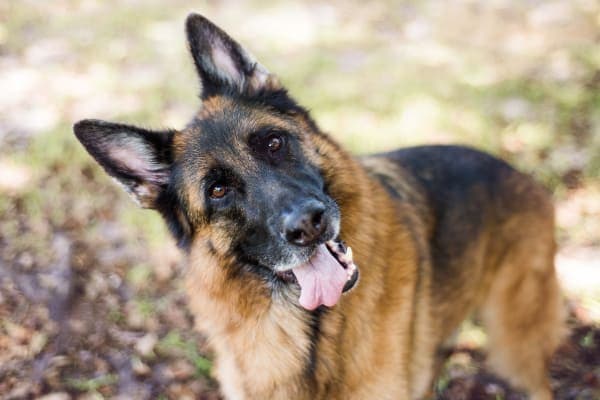
Laryngeal anatomy in dogs
To understand how tie back surgery may improve a dog’s life, it’s important to have a basic understanding of laryngeal anatomy.
The larynx houses the vocal cords, which is why it’s also known as the “voice box.” It is composed of muscles and cartilage, and is situated at the opening of the windpipe (trachea) in the back of the throat. The opening to the esophagus is adjacent to the larynx.
In a healthy animal, muscles open the larynx during breathing and close the larynx when swallowing to prevent food or water from entering the lungs. Two cartilage flaps — one on the left and one on the right of the larynx — function like a set of double doors that open and close to control what enters the trachea.
Laryngeal paralysis explained
For dogs with laryngeal paralysis, the cartilage “doors” are broken. They may not open or only partially open. Turbulent, restricted airflow going past poorly functioning cartilage fold(s) causes the noisy, raspy breathing we associate with this condition. (Do you get the visual picture on why the its called the “tie back” surgery?)
The weak folds also increase the risk of aspiration (food or water being inhaled into the lungs) since the “door” to the upper airway doesn’t shut properly, leaving the airway unprotected during eating and drinking. If you have ever taken a drink and ended up coughing and sputtering because it “went down the wrong pipe” you have some idea what this is like.
Signs of laryngeal paralysis in dogs

Laryngeal paralysis commonly affects older, large breed dogs. Clinical signs, like those Max had, include:
- Raspy breathing
- Changes in the dog’s bark
- High-pitched noisy breathing (stridor) which may worsen with exercise or excitement
- Coughing or gagging, especially when drinking or eating
- Lack of energy
- Increased panting/respiratory effort
Increased difficulty breathing can cause a dog to become anxious, which in turn increases respiratory effort even more. In some cases this can snowball into a respiratory distress crisis. For many pet parents, the motivation to prevent recurrence of a life-threatening respiratory crisis is the number one factor in their decision to proceed with the tie back surgery for their dogs.
Progression of laryngeal paralysis
Laryngeal paralysis is a progressive disease. Symptoms usually start out mild and become more obvious with time. Some dogs also develop generalized weakness in their hind end because we now believe that laryngeal paralysis is one component of a condition called Geriatric Onset Laryngeal Paralysis Polyneuropathy (GOLPP). The word “poly neuropathy” means many nerves are involved and explains why the nerves and not the muscles are the real problem with lar par.
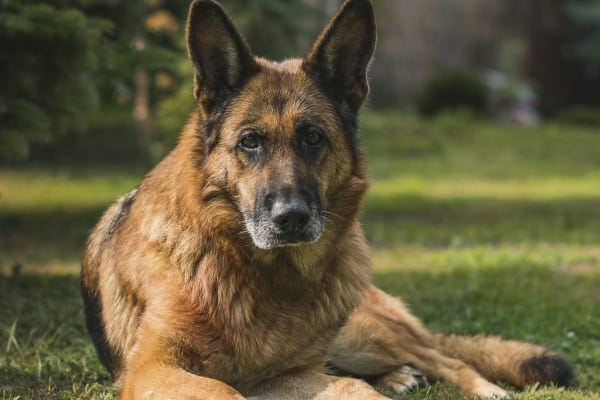
How do veterinarians treat laryngeal paralysis?
Unfortunately, there is no effective long-term non-surgical medical treatment for laryngeal paralysis. Dog parents may use these strategies to manage milder cases:
Home management changes:
- Eliminate the use of a neck lead (collar)
- Restrict activity
- Avoid overheating
- Reduce anxious situations
- Changing at mealtime
Medical management: - Anti-anxiety medication
- Anti-reflux medications
- Doxepin
Alternative treatments: - Massage
- Physical therapy
- Acupuncture
While these nonsurgical treatment options can help manage mild to moderate cases, as the disease progresses, often tie back surgery offers the greatest opportunity for best quality of life.
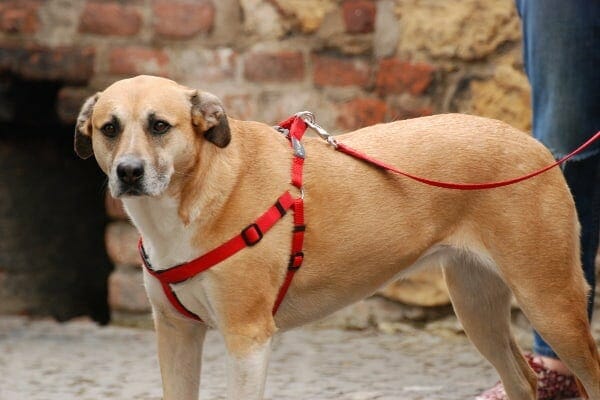
Max’s story continues
Max’s parents decided to start with conservative treament. His owner only walked him on a harness, restricted exercise to the cooler times of day, and started him on medications. Some days were better than others, but he did okay.
But I’ll never forget the day his mom rushed him into the clinic in true respiratory distress. He was in a life-threatening crisis. Thankfully, we were able to stabilize him with IV medications and oxygen therapy, so Max could be referred to a soft tissue veterinary surgeon. The specialist discussed treatment options and pros and cons. Max’s family decided tie back surgery was the right decision for him.
What is tie back surgery for dogs?
While there are different surgical treatment options available, the most common procedure performed by veterinary surgeons is a unilateral arytenoid lateralization, or “tie back” surgery.
Tie back surgery for dogs involves changing the anatomy of the larynx. During tie back surgery, the veterinary surgeon makes a small incision in the side of the dog’s neck and sutures the cartilage flap on one side of the larynx in a permanent, semi-open position. Think about it as permanently propping one of the “doors” of the larynx partially open to improve air flow.
By opening just one side, the surgeon achieves a sort of happy medium with larynx function. The cartilage flap cannot close and cause breathing obstruction, but it also is not completely open, which would make it even more difficult to protect the airway from aspiration—food or water going down that wrong pipe.
What can I expect after tie back surgery for dogs?
To give you a better idea of what to expect after tie back surgery for dogs, let’s check in with Max again.
Post-operative instructions after tie back surgery for dogs
Max’s tie back surgery was hugely successful and his mom followed the surgeon’s post-operative instructions to the letter. For six weeks, Max was “grounded.” He went for a few five-minute walks a day mostly for potty breaks. She kept Max from getting too active or excited as much as possible—no easy feat since Max, even with his grey muzzle, was known to clear multiple coffee tables a day with his wagging tail.

Setting expectations after tie back surgery
At his next appointment, Max’s mom had some concerns to discuss with me. Although he didn’t breathe with the same disturbing effort, his breathing was still louder than it was before his laryngeal paralysis started and his bark still sounded hoarse.
Max’s owner was relieved but disappointed when I explained to her that these symptoms are normal for dogs with laryngeal paralysis even after tie back surgery and are unlikely to resolve.
If your dog has tie back surgery, keep in mind that the surgery does not restore normal function to the larynx, so some of the clinical signs of lar par may still present after surgery. And like any surgical procedure, there are potential risks to anesthesia and surgery. A tie back surgery does not guarantee success.
But a tie back surgery can help your dog breathe better, feel better, and greatly reduce the risk of severe respiratory distress—that life-threatening breathing crisis.
I think it’s helpful to consider the thoughts of other dog parents who’ve been in your shoes.
The Tie Back Surgery Study by Dr. Mary Gardner
Dr. Mary Gardner, co-founder of Lap of Love Veterinary Hospice, recently surveyed 422 people whose dogs had been diagnosed with laryngeal paralysis. Roughly half of those had chosen tie back (or similar) surgery for their dogs, and the other half were managing the condition nonsurgically.
More than half of the respondents whose dogs had the tie back surgery reported that after recovering from the procedure, their dogs played more, were more active, and slept better. Eighty-seven percent indicated that their dogs had more energy. Perhaps most interestingly, 9 out of 10 of those people said they would do it again.
Long-term restrictions after tie back surgery
Like Max’s mom, owners of dogs who have tie back surgery should abide by the following rules:
1. Use a harness instead of a collar.
Use a harness when walking your dog on a leash to take pressure of the neck.
2. Prevent your dog from overheating.
Even after tie back surgery, our canine companions with laryngeal paralysis continue to be at a higher risk of developing heat stroke in dogs. This is because they still may not be able to cool themselves adequately when panting.
Pay attention to the temperature and humidity outside, restrict walks to the cooler part of the day, and keep the house cool in the summer. Air conditioning serves to lower the temperature and reduce humidity—both key to the well-being of lar par dogs.
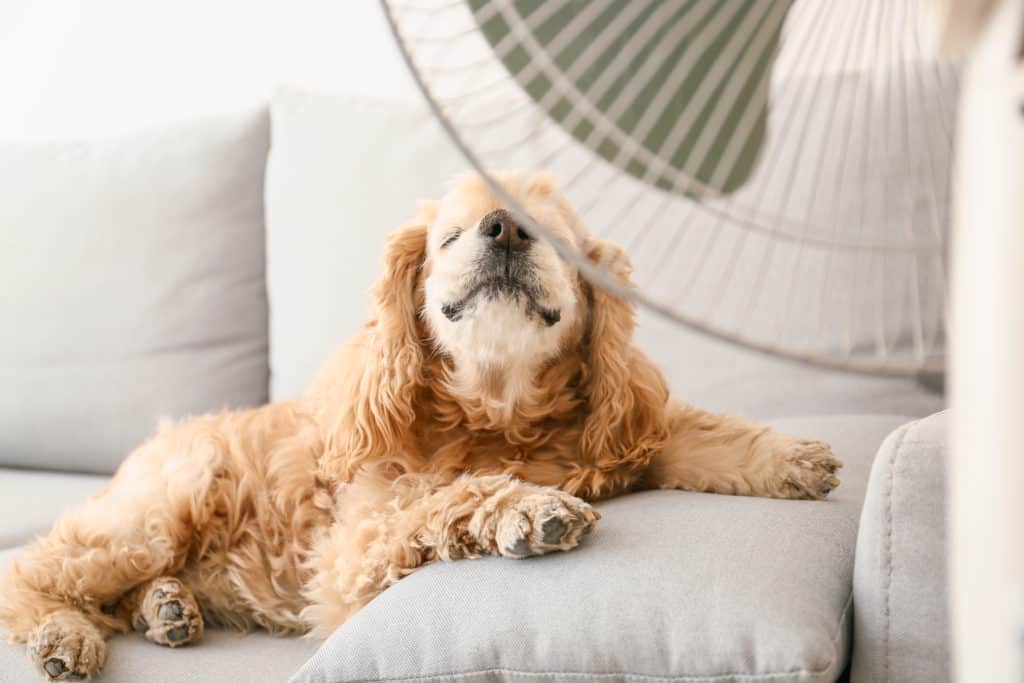
3. Avoid taking your dog swimming.
Ideally, avoid swimming. The tie back surgery opens half of the larynx permanently, so the risk of aspirating while swimming can be high.
If you have a dog who loves to swim, it might be an option to let them do so when using a dog life vest that has been modified to protect the airway. But before allowing your dog to swim with the modified life vest, please consult with your veterinarian or veterinary surgeon as it may not be a safe option for all dogs.
4. Help your dog achieve an ideal weight.
Ensure your dog is the ideal weight with the canine body condition score. If your dog is overweight, work with your veterinarian to develop a weight loss program. Losing excess fat around the chest and throat can make breathing easier.
Aspiration pneumonia after tie back surgery for dogs
Echoing the surgeon’s counsel, I cautioned Max’s owner to watch for signs of aspiration pneumonia, a lung infection which may occur when foreign material (like food particles) enters the lungs. Approximately 15 to 20% of dogs experience aspiration pneumonia after tie back surgery. Since the larynx cannot completely close, the risk of inhaling food and water when eating or drinking is increased. We talked about trying a slow feeder bowl to reduce the aspiration risk by “pacing” Max’s meals.
Signs of aspiration pneumonia in dogs
I also asked his owner to monitor his breathing and temperature for the following changes, which can be early signs of aspiration pneumonia:
- Increased respiratory rate
- Changes in respiratory effort
- Coughing
- Fever
- Lethargy
- Nasal discharge
- Decreased appetite
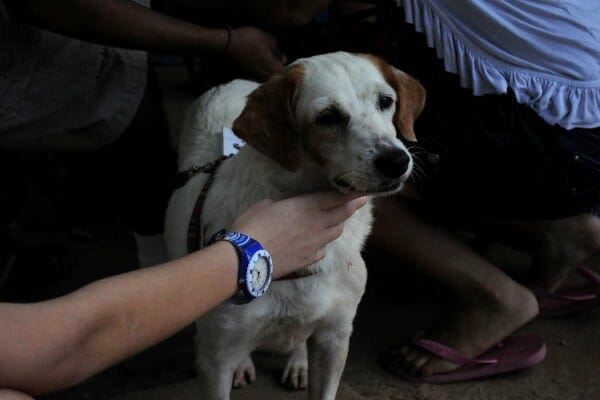
The conclusion of Max’s story
Despite his modified lifestyle, the tie back surgery drastically improved Max’s quality of life for several years. He breathed more easily and did not have another episode of respiratory distress like the one that lead him to need the tie back surgery. His story is simply one of many that have made me a believer in the life-saving and life-changing benefits of tie back surgery for dogs.
Sadly, the underlying neurologic issues causing Max’s laryngeal paralysis progressed, and he developed significant weakness in his hind end. Nearly two years after his tie back surgery, Max’s mom decided it was time.
Together we celebrated Max’s long life, and the “bonus” time his owners had with him after his tie back surgery. They knew that saying goodbye to a dog is heartbreaking, but it was their final gift to Max.
I want to share one more story with you. It’s a story of finding hope and community in the midst of fear and uncertainty. Keep reading to discover how one dedicated dog mom’s laryngeal paralysis journey with her heart dog, Rusty, led to the creation of a Facebook group that has helped thousands of people whose families have been touched by lar par.
Rusty’s story: Tie back surgery for dogs
Rusty’s story with laryngeal paralysis began simply enough. His owner, Wendy, suspected he had an ear infection, so she scheduled an appointment with her local vet. The day of the appointment, Wendy’s husband noticed Rusty’s breathing had changed.
They both knew something was wrong.
They hurried to the veterinary clinic as Rusty began to struggle. Wendy wisely called to give the clinic a heads up that Rusty had more than just an ear infection. As soon as they pulled in the parking lot, the vet staff rushed them to the treatment area where Rusty received oxygen and medication to get him stabilized.
The vet recognized the urgency of the situation and presumptively diagnosed Rusty with laryngeal paralysis. This was an emergency, and Rusty would need to be transferred for 24-hour care.
After leaving Rusty at a specialty hospital overnight, Wendy and her husband learned the full extent of his condition the following day — one laryngeal fold wasn’t functioning at all, and the other was only functioning at 25%. The vet told them Rusty was a good candidate for tie back surgery.
Because Rusty was 12 years old, Wendy and her husband weren’t sure if tie back surgery was the right course of action. Like many owners of dogs with lar par, they were dubious about the wisdom of putting their senior dog through anesthesia and surgery with no guarantees.
In the end, however, they decided to move forward with it. Rusty recovered from surgery happy and healthy, and Wendy and her husband were incredibly thankful they had decided to do the tie back surgery.
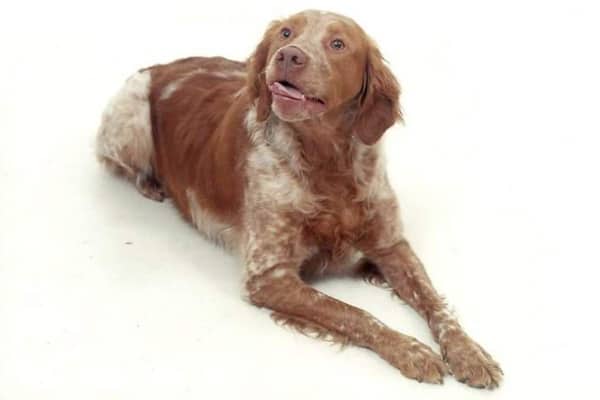
Laryngeal paralysis support group
After walking with her senior dog through a laryngeal paralysis diagnosis and surgery, Wendy and her husband wanted to do something to help others.
“When we were in the heart of Rusty’s situation, there really wasn’t a place for us to go. I would talk to my regular vet, but when I would get off the phone or leave the office, I’d have a million other thoughts and questions. When things went bad fast, we didn’t know who to talk to or where to turn for advice and encouragement. It was just my husband and I trying to figure it out,” Wendy shares.
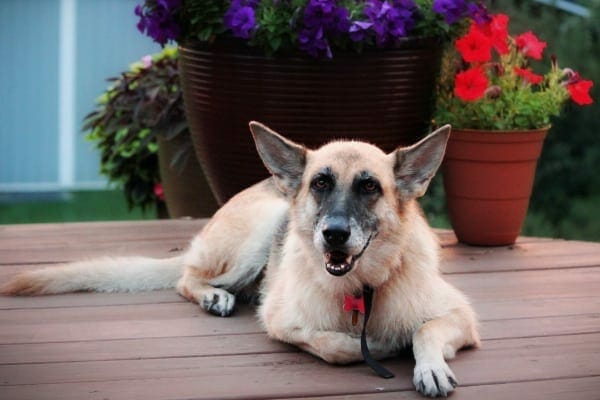
On Facebook one day, Wendy chatted with a friend through her rescue group who was going through the same thing. As she and her friend talked and offered support to one another, a light bulb clicked on in Wendy’s head. “Maybe if I create a Facebook group, I can help even more people!”
Wendy guessed the group might reach thirty or forty members. Today the group has over four thousand members. As a member of the group, I can personally attest to the compassionate support and valuable information exchanged.
In fact, it’s the group that Dr. Mary Gardner, whose dog also had tie back surgery years ago, surveyed to collect her data. Members discuss “all things lar par” (not just tie back surgery) and respect for whatever choices owners make for their own dog’s situation is a standard Wendy insists upon.
Hope for dogs with laryngeal paralysis
If your dog has laryngeal paralysis and you’re considering tie back surgery, know you’re not alone. There are hope and options for your beloved senior dog. Here are two things you can do today to ease your worries and begin to get the answers that you need.
- Speak with your vet. Ask your vet about specialists in your area who can discuss the pros and cons of tie back surgery for dogs. Even if my clients determine that surgery is not the right course of action after meeting with a specialist, I encourage them to get the second opinion for peace of mind. Knowledge is power.
- Join Wendy’s support group. The Facebook group called Laryngeal Paralysis (LP) Support Group (Dogs) will be a tremendous source of empathetic support and helpful tips.

Are you considering tie back surgery for your beloved dog?
Please comment below. We can all support each other.


My dog (a rescued husky/germanshepherd mix X Staffordshire Bull terrier) had breathing issues, last year and was diagnosed with laryngeal paralysis. I decided immediately on the surgery due to his difficulty in breathing with a roaring sound. It was successful a year ago but recently he had to have emergency intubation to make him breathe and he had aspiration pneumonia. The vet took x-rays and for some reason the surgery on the left had failed. I decided to proceed with right hand side surgery recently as the only alternative would be euthanasia and although he is 17 years of age, when well is still bouncy, can jump on the sofa and enjoys his hour walk every day. He takes Librela and Loxicom for some arthritis. He actually recovered well from the surgery better this time than a year ago. A bit more acid reflux which is manageable. Due to our dry heating system in the house I invested in a humidifier which helps. I have a ceiling fan light in the summer and cool coats. The only thing is he has lost his bark and left with a strange noise. I live in Scotland, United Kingdom. I guess I am lucky that he didn’t have many recovery issues like some.
Hi Alison,
Goodness your boy has been through a lot over the past couple of years. What a blessing the surgery was successful and has restored his quality of life. Thank you for sharing your experience with us. It is very helpful to others to hear about positive outcomes! Hoping you have many happy days ahead and wishing you and your senior guy the best.
I have a 13 year old lab who had tie back surgery 5 weeks ago the problem he has is with eating and drinking and just walking 10 feet his stomach jumps and he looks like gaging but I can hear him burping why is his stomach doing this I sent video to surgery center all I get back is coughing and gaging are normal and I might want to take to my regular vet she didn’t seem to concerned but saw stomach really jumping
Hi Mario,
I am sorry you are dealing with this stressful situation with your senior dog. I understand your concern and it sounds justified. Unfortunately, without examining your pup myself, I can’t make specific conclusions. With you hearing burping, it has me suspicious that maybe your dog is swallowing to much air while trying to eat/drink. This could be harmless but could also predispose him to bloat. I think you should reach out to your vet again and let them know this is an ongoing issue. If needed, never hesitate to seek out a second opinion. I hope you can find the answers you need to keep your sweet boy happy and healthy. Wishing you all the best.
Hello,
My 10-year-old Great Pyrenees mix named Cubby had tie back surgery 6 weeks ago. He has a terrible cough post-op. A dry cough which has led to a gagging reflex. Recently his cough has kind of morphed being less often but an intense honking dry cough followed by sneezing fits. It happens most when he is laying down or just getting up. Symptoms disappear after a few minutes walking. His airway is open, and he breathes well. The surgeon thought he may have perforated Cubby’s mucosa during surgery, but a subsequent upper airway scope revealed nothing. Also he has had chest x-rays and he has not contracted aspirate pneumonia. I’m at a loss as to what to do next. I want to give him more time, but he is pretty unhappy alot of the time. Any ideas would be appreciated. thank you
Hi Michael,
I am so sorry Cubby is experiencing these severe symptoms after his tie back surgery. Honestly, I usually defer to the specialist in cases like this. If the surgeon hasn’t found the cause of his coughing, I am not sure what the next step should be. Maybe it is time to seek out alternative therapies? You might want to see if there is a vet in your area that practices Eastern medicine such as Traditional Chinese Veterinary Medicine. Acupuncture or an herbal supplement could potentially be the solution to this very puzzling issue. I hope you can find the answers you need to get Cubby back to living his best life. Feel free to leave an update if you have a chance.
Thank you so much for this article!
I would like more information about the tie back surgery. I have read quite a bit about it but can’t find anyone who actually does the surgery. I live in Mammoth lakes, CA so can go to Southern California or the Reno Nevada area for surgery. My dog is an 11 year old Great Pyrenees mix and I just hate to hear him suffering with the breathing, although he remains happy and ready to go on walks.
Hi Emily,
For more detailed information you will probably need to talk to a surgery specialist. Most specialists require a referral from your general practice vet. Make sure your vet is aware you are interested in pursuing a referral and they should be able to find someone who can do this procedure for your dog.
I have a six year old puggle who had tie back surgery last week. The reason for her paralysis was collar abuse.
We’re 1wk 2 days in and I don’t see any improvement. In fact, she almost seems worse. I have been feeding her only soft foods as required. As far as activity level, I try to keep her down as much as possible, but at 6yrs old and with two puppies in the house, it’s difficult.
Do you think if she’s too active or tries to bark it would cause the stitches tying the larynx flap back to bust? I sure hope we didn’t screw this up considering the cost and how much the pups and I absolutely love her. She’s the leader of the pack here and life just wouldn’t be the same without her…..
The labored breathing is so hard to listen to at night 🙁
Hi Candice,
I am sorry your little dog is struggling so badly post-op. It is possible that there is swelling or inflammation causing these continued breathing difficulties. With that being said, I am not used to seeing the type of labored breathing you are describing in my patients that have recently had tie back surgery. Have you talked to your vet about these concerns? I highly recommend you have her evaluated by your vet as this could be a sign of surgical failure or other complications such as aspiration. I hope you can find some answers and help restore your pup’s quality of life. Wishing you the best.
We had great success with the tie back surgery in May. Our 13 year old Lab named River had an emergency situation when she couldn’t catch her breath and gums started turning blue. It was horrible to watch – thankfully we got to the vet in time(within minutes) and they did the emergency tie back. So thankful we did it, otherwise we would have lost her that day. She has so much energy now and not straining to breathe. We highly recommend it.
Hi Michelle,
This is such great news! What a blessing the surgery was successful, and River is back to living her best life. Thank you for sharing your story with us. Wishing you all many happy years ahead!
Hello everyone,
My young lab/mix was diagnosed with LP at 3 years old. I proceeded with this expensive surgery back in 2020. now 2 years later her original symptoms are back. Upon examination, the vet said there is no sign of the tie back procedure and my dog is struggling to breath again. Is this normal? Does it come undone? I can’t afgord to pay $6000 again, but I lover her to pieces .
Hi Andrea,
I am sorry your pup has struggled so badly with LP and its effects. While there is a potential for any surgery to fail, I am not familiar with a tie back surgery having issues such as you describe this many years post-op. It might be a good idea to have your girl evaluated by a neurologist or other specialist to make sure nothing else is contributing to her symptoms. I hope you can find the answers you need to make the best choices for you and your dog. Praying for a positive outcome.
I don’t mean to be a “Debbie Downer” but I have to ask some questions, and if anyone has insight, I welcome the advice! We have a 13 year old rescue dog (possibly beagle/lab/husky mix?) who needs tie back surgery. I am a teacher. I lost my husband to brain cancer in 2016 and I have two children in college. I hate to say cost is an issue, but cost is an issue. How much is the typical surgery? This is just breaking my heart, but I’ve been teaching for 27 years and have a Master’s degree plus 48 graduate level hours and am just now breaking the $60,000 a year mark. I am just getting by as it is. Thoughts? Thank you!
Hi Gail,
I understand your concern for your senior dog and the added pressure of financial constraints. Your best bet is to call your local specialty clinic or referral hospital and ask for a quote for tie back surgery. Surgery cost varies greatly with what city and state you are located. Also, the size of the dog and other complicating factors can play a role in what a surgeon will charge for this procedure. Some general practitioners will perform this surgery, but others will want to refer to a specialist. You can always ask about payment plans or if they take options like care credit. I am hopeful you will be able to find the help you need to take care of your pup. Bless you.
Hi. Thank you for all the information. My 15-year-old Australian cattle dog was diagnosed with laryngeal paralysis about a year ago. She also has COPD and Cushing’s disease. My vet says that he would not perform the tie back surgery on her but never stated a reason other than her Advanced age. She is definitely struggling in the heat. I would like to know more about the surgery and if Greystone would be a candidate for it. . Thank you.
Hi Kim,
I understand your concern for Greystone, and he is lucky to have you advocating for his health and wellbeing. Since I have not examined your dog myself, I can’t make specific conclusions or recommendations. Your vet may be worried about the COPD and Cushing’s disease making your dog a less than ideal anesthesia candidate. My best recommendation is to contact a veterinary surgery specialist in your area. They can review your pup’s case and let you know if this surgery is an option. The specialist should also be able to address any unanswered questions or concerns you may have and go over the procedure in more detail. I hope you find the answers you need to make the best decision for you and Greystone. Best wishes to you both.
We just experienced the same terrifying scenario with our 13 year old beloved cockapoo and have scheduled tie back surgery. Any tips on best feeding methods? We already have him on a slow feeder and are grinding up his food so it’s the consistency of soft serve ice cream, but curious about other/better methods post-opp?
Hi Jessica,
I am sorry you had to go through such a traumatic experience with your senior guy. I am glad you have surgery scheduled and hope everything will go smoothly. The specialist that performs tie back surgery in my area usually recommends feeding canned food (pate, not the chunks in gravy) post-surgery for a few weeks. He asks that the canned food be made into small “meatballs” so that it is easy to swallow. He also recommends hand feeding so you can control the pace and keep it slow. I am sure your surgeon will have specific after care instructions, and it may be a bit different. Praying for a positive outcome for your sweet boy. Wishing you both the best. ♥
I can relate to the experiences and posts above as my own dog had tieback surgery. He did well post surgery but I think I had unreasonable expectations post surgery. Like Max’s owner, I was relieved but disappointed to find that his breathing, though so much improved, was still noisy at times, especially with exertion. Hot and humid days can still affect his breathing. But his bark has improved some and he is still better off than pre-surgery. The support group on Facebook is priceless. The support and info you get from that Facebook group is second to none! This article provided support as well among those of us who have gone ahead with tie-back surgery.
Hi Vikki,
Thank you for sharing your experience with our readers. I am glad you mentioned the Facebook group as it may be a valuable tool for someone else in a similar situation. I am glad your pup is doing well and seems to have a good quality of life. Wishing you both many happy days ahead!
Wonderful article with good information and heartwarming stories.
Thanks for the kind words Jenny!
Wow! I wish I had read this before having to make the decision to have tieback surgery on our 11 year old yellow lab, Sib. Only a few weeks prior, I received the hysterical call of a crying husband stating to get home as soon as possible that Sib was dying. It was an unseasonably warm day in November in Northern Michigan and my husband took our boys (Sib and Angus, an 11 month old yellow puppy) for their daily walk. He did not take the ice cold water with him or turn around at the first sign of trouble. He had to call a friend to come and get them in the woods as Sib was in respiratory distress, but they did not take him to the vet’s. They took him home where my husband did not take him inside to the AC and fan. Instead, Sib laid out on the cement fighting for his life. Only after I said get him in the truck and get to vet’s, my husband was able to lift Sib’s dead weight into the truck. By the time they arrived (vet met them outside), Sib had recovered from being in the AC. The vet asked my husband “Is it time?” as in euthanasia. My husband responded with a forceful “No!” By this time, I arrived and had put all the pieces together so I was fuming, but didn’t have to say a word. The vet came out shortly after to say “He did not require much as he had recovered, but we had to do something.” We were referred to MSU. This was by far a day of panic that was unnecessary and it took a few days for Sib to truly recover. A guardian angel was on his side that day.
As a nurse, I researched all the information that I could find including any research articles about tieback surgery. MSU had been researching the disease so I knew it was the right place.. I understood the anatomy and physiology of the disease. However, to explain this to my husband was extremely challenging. This post explains LarPar/GOLPP in layman’s terms that he would understand. My biggest fear wasn’t the surgery. It was aspiration pneumonia and still is. Recovery from surgery is nothing, only a few days. AP is so much harder on the body and can take weeks to overcome.
Upon arrival to MSU for his consultation on Monday, Sib was immediately placed in ICU on oxygen. Sib is a laid back dog and doesn’t get overly anxious. This fact that he was struggling to breathe under relatively normal circumstances made my decision easy. He had surgery the following day after confirming bilateral paralysis via laryngescope. We picked him up a day after surgery on Wednesday (the day before Thanksgiving). It was a long 3.5 hour ride home. Angus had to come as we were gone for days. Angus was excited to see his brother but has always been very respectful. Sib was so drugged that Angus took the brunt of his wrath, which was out of character for Sib. Once home, Sib started throwing up and could barely stand without falling over. I got him on his bed and enjoyed loving on him and listening to easy breathing. I slept next to him all night on the floor. By morning, he was coughing. (MSU did not treat his acid reflux while there, which I understand, but probably attributed to AP.) I heard crackles in his lungs. I made a call to our local vet. She met me at the clinic and gave us some injectable antibiotics (remember I am a nurse) and we changed all of his meds. Gabapentin was too much for him. Within a day, Sib was prancing again on our driveway walks. We mastered his new meatball diet. We continued to fight the reflux. About a month ago, he ended up with AP again. He had a temp of 103 (MSU said to be concerned with this temp eventhough high normal, but it was night and he wasn’t panting or active). He was have some abdominal breathing and lungs had wheeze. Placed call to vet’s office. Sent video and we met at vet’s 30 minutes later. X-rays showed some very patchy infiltrates, which suggested early AP). He was placed on antibiotics. At this vet’s suggestion, we changed his reflux meds to reglan (prokinetic to help move food) and lansoprazole. Eureka! This combo has been a game changer.
Sib is my unicorn. He was bought on a whim and is by far the smartest, most intuitive dog ever. He does not require a leash as we are his life. No interest in other people or dogs. He is completely devoted to us. He should’ve been a therapy dog. I am thankful that we had the means to do surgery. I don’t regret it for a minute. Every day is a blessing.
I hope that someone who is going through this can find peace in making a decision through Dr. Buzby’s post and mine. No, I don’t have a crystal ball to tell the future…I just had to take a leap of faith, believe in the surgeon, and trust that Sib was still willing to fight as I will continue to fight for him. He is worth it!
Alison,
Wow! I love this story, especially the last two paragraphs. Thank you so much for taking the time to share Sib’s tie back journey in hopes that it will help other pet parents who are struggling with that decision. I am so happy that it worked out well for him despite his bouts of aspiration pneumonia and that he is continuing to live the good life with you. ❤
I found your story seriously helpful. I am also in MI and maybe I also will speak with MSU about our GOLPP. Our primary vet seems quite against the surgery. maybe I need another opinion.
Thank you for this very informative & easily understood article! My 16 year old dog has been diagnosed with GOLPP & I’m researching the disease.
Hi Wendy,
Sorry to hear that your dog was diagnosed with GOLPP recently. It can feel overwhelming sometimes to be faced with the diagnosis of a complex and not fully understood disease, but you are not alone! I’m glad that the article was helpful to you in your quest for information and I applaud you for trying to learn all you can about the condition. We very much appreciate your kind words about the article because it means we are accomplishing our goals of informing and empowering dog parents. ❤